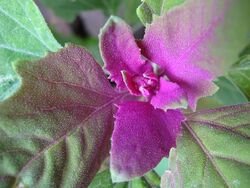Biology:Chenopodium giganteum
| Chenopodium giganteum | |
|---|---|

| |
| Close-up of Chenopodium giganteum | |
| Scientific classification | |
| Kingdom: | Plantae |
| Clade: | Tracheophytes |
| Clade: | Angiosperms |
| Clade: | Eudicots |
| Order: | Caryophyllales |
| Family: | Amaranthaceae |
| Genus: | Chenopodium |
| Species: | C. giganteum
|
| Binomial name | |
| Chenopodium giganteum D.Don
| |
| Synonyms[1] | |
| |
Chenopodium giganteum, also known as tree spinach, is an annual, upright many-branched shrub with a stem diameter of up to 5 cm at the base, that can grow to a height of up to 3 m.[2]
Description
The younger leaves of Chenopodium giganteum are hairy with a magenta colour and the older become green. The rhombic to ovate formed lamina can have a surface of up to 20 x 16 cm. The inflorescence consists of terminal panicles with hermaphrodite flowers, which are wind pollinated.[2][3] The flowers contain 5 perianth leaves and 5 stamens. The flowering period begins in August. The seeds have a diameter of 1.5 mm.[2] The number of chromosomes is n=54.[4]
Habitat and distribution
Chenopodium giganteum belongs to the same genus as quinoa or Chenopodium album. Many species of this genus have a long history of domestications as grain, vegetable or forage crops.[5] Therefore, genetic relationships and place of origin are hard to determine. Chenopodium giganteum has two main subspecies: one originating from India the other from America.[4]
It grows well in Mediterranean environment but needs full or partial shade. Chenopodium giganteum does not have high requirements on soil quality.[6] Furthermore, it shows weedy characteristics such as fast growth and rapid spreading.[7] In a few countries, such as Germany and Slovakia, Chenopodium giganteum has been reported as a neophyte.[8][9] The commercial cultivation of Chenopodium giganteum is nearly inexistent. But because of its stable and high yield Chenopodium giganteum could be a plant of the future.[10]
Use
The young shoots and leaves of Chenopodium giganteum can be eaten cooked like spinach, another member of the Amaranthaceae. Most of the oxalic acid and saponins are removed during the cooking process, especially if boiled for 2 minutes at 100 °C (212 °F).[11][12] However, the leaves are also edible raw in lower quantities, for example as a salad.[7] The seeds can be prepared similar to rice or quinoa or can alternatively be ground into flour, which is then mixed with cereal flour for bread making.[3][13]
Due to the partially pink coloured leaves, Chenopodium giganteum also has an ornamental value.[13]
Nutrition
As common for species of the family Amaranthaceae, the plants contain some amounts of saponins and oxalic acid,[3][14][15][16] which in high concentrations can have negative health impacts on humans (e.g. Hemolysis or Kidney stone disease).[17]
References
- ↑ "Chenopodium giganteum D.Don". Board of Trustees of the Royal Botanic Gardens, Kew. 2017. https://powo.science.kew.org/taxon/urn:lsid:ipni.org:names:173408-1.
- ↑ 2.0 2.1 2.2 Zhu, Gelin & Mosyakin, Sergei & E. Clemants, Steven. (2003). Chenopodiaceae (Flora of China). in Flora of China, Volume 5, Chapter: Chenopodiaceae, Beijing: Science Press & St. Louis: Missouri Botanical Garden Press, Wu Zhengyi, Peter H. Raven, pp. 351–414
- ↑ 3.0 3.1 3.2 "Chenopodium giganteum Tree Spinach PFAF Plant Database". https://pfaf.org/user/Plant.aspx?LatinName=Chenopodium+giganteum.
- ↑ 4.0 4.1 Rana, Tikam; Narzary, Diganta; Ohri, Deepak (2010-03-01). "Genetic diversity and relationships among some wild and cultivated species of Chenopodium L. (Amaranthaceae) using RAPD and DAMD methods". Current Science 98: 840–846. https://www.researchgate.net/publication/287508938.
- ↑ "Chenopods, Chenopodium spp." (in en). https://www.bioversityinternational.org/e-library/publications/detail/chenopods-chenopodium-spp/.
- ↑ De Santis, Giuditta; D’Ambrosio, Tiziana; Rinaldi, Michele; Rascio, Agata (July 2016). "Heritabilities of morphological and quality traits and interrelationships with yield in quinoa ( Chenopodium quinoa Willd.) genotypes in the Mediterranean environment". Journal of Cereal Science 70: 177–185. doi:10.1016/j.jcs.2016.06.003. ISSN 0733-5210.
- ↑ 7.0 7.1 Fowler, Alys (2011-07-08). "Alys Fowler: Tree spinach" (in en). https://www.theguardian.com/lifeandstyle/2011/jul/08/alys-fowler-tree-spinach.
- ↑ Medvecká, Jana; Kliment, Ján; Májeková, Jana; Halada, Luboš; Zaliberová, Marica; Gojdičová, Ema; Feráková, Viera; Jarolímek, Ivan (2012). "Inventory of the alien flora of Slovakia" (in en-GB). https://www.mendeley.com/catalogue/inventory-alien-flora-slovakia/.
- ↑ Amarell, Uwe (2010). "Bemerkenswerte Neophytenfunde aus Baden- Württemberg und Nachbargebieten (2004–2008)" (in en-GB). https://www.mendeley.com/catalogue/bemerkenswerte-neophytenfunde-aus-baden-w%C3%BCrttemberg-und-nachbargebieten-20042008/.
- ↑ Bhargava, Atul; Shukla, Sudhir; Ohri, Deepak (2006-09-27). "Evaluation of foliage yield and leaf quality traits in Chenopodium spp. in multiyear trials" (in en). Euphytica 153 (1–2): 199–213. doi:10.1007/s10681-006-9255-8. ISSN 0014-2336.
- ↑ ISHII, YUUKO; TAKIYAMA, KAZUYOSHI (1991). "CHARACTERIZATION OF OXALIC ACID IN VEGETABLES" (in en). Analytical Sciences 7 (Supple): 811–814. doi:10.2116/analsci.7.supple_811. ISSN 0910-6340.
- ↑ Wang, Zheng; Ando, Akira; Takeuchi, Atsuko; Ueda, Hiroshi (2018). "Effects of Cooking Conditions on the Relationships Among Oxalate, Nitrate, and Lutein in Spinach" (in en). Food Science and Technology Research 24 (3): 421–425. doi:10.3136/fstr.24.421. ISSN 1344-6606.
- ↑ 13.0 13.1 Gatersleben, Dr. Jörg Ochsmann, Dr. Gisela Weber, Dr. Ram Narang IPK. "Mansfeld World Database on Agricultural and Horticultural Crops" (in de). http://mansfeld.ipk-gatersleben.de/apex/f?p=185:46:0::NO::module,mf_use,source,akzanz,rehm,akzname,taxid:mf,,botnam,0,,Chenopodium+amaranticolor,421.
- ↑ Al-Saleh, G F S; Gamal El-Din, A Y; Abbas, J A; Saeed, N A (January 1997). "Phytochemical and Biological Studies of Medicinal Plants in Bahrain: The Family Chenopodiaceae—Part 2" (in en). International Journal of Pharmacognosy 35 (1): 38–42. doi:10.1076/phbi.35.1.38.13266. ISSN 0925-1618.
- ↑ Mroczek, Agnieszka (2015-01-24). "Phytochemistry and bioactivity of triterpene saponins from Amaranthaceae family" (in en). Phytochemistry Reviews 14 (4): 577–605. doi:10.1007/s11101-015-9394-4. ISSN 1568-7767.
- ↑ Siener, Roswitha; Hönow, Ruth; Seidler, Ana; Voss, Susanne; Hesse, Albrecht (January 2006). "Oxalate contents of species of the Polygonaceae, Amaranthaceae and Chenopodiaceae families". Food Chemistry 98 (2): 220–224. doi:10.1016/j.foodchem.2005.05.059. ISSN 0308-8146.
- ↑ "GESTIS Database" (in en). http://gestis.itrust.de/nxt/gateway.dll/gestis_de/017910.xml?f=templates$fn=default.htm$3.0.
Wikidata ☰ Q486904 entry
 |

